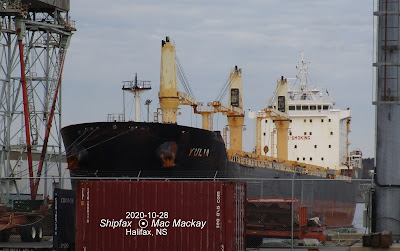A ship with a long connection to Halifax has been retired and designated for scrap.
Built in 1980 as Nanticoke the ship was among Canada Steamship Line's "salty lakers". These were ships of maximum size for the St.Lawrence Seaway, but also designed to make short forays into ocean waters. A self-unloading bulk carrier, it had a maximum capacity of 35,100 tons.
Nanticoke was built by Canadian Shipbuilding + Engineering at Collingwood, ON, and measured 21,870 grt, 35,686 dwt. It brought grain to Halifax from the Lakes, and usually loaded gypsum as a backhaul.
In the first years the Halifax grain elevator did not have a way for self-unloaders to unload. The grain leg was used until a hopper could be added to the unloading tower.
In 1997 the ship participated with two of its CSL fleet mates in a very unusual operation. The ships were fitted with special unloading gear to carry a heavy aggregate called magnetite from the quarry in Newfoundland to the offshore location of the Hibernia oil field. There the ships discharged the material, as a slurry, into the Hibernia gravity base, ballasting it down to its permanent location. The ships were fitted out in Dartmouth and returned to Dartmouth to have the gear removed.
Temporary unloading gear was mounted on the ship's bow.
In 2009 Nanticoke entered into a long term charter arrangement with the operators of the Magdalen Islands salt mines. It then took the distinctive name Salarium. In ancient times salt was used as currency, and a payment in salt was termed "salarium", from which our present day word salary is derived. By that time CSL's self-unloading bulk carriers in domestic service were repainted in CSL's traditional red. (Self-unloaders had previously been painted black, which was thought to be more serviceable because of the amount of coal they carried.)
As Salarium the ship then spent most of its time carrying salt to ports in the Great Lakes / St.Lawrence, but occasionally ranging as far as Saint John, NB. It still carried gypsum or other cargo from time to time as a backhaul, but its grain carrying days were over.
Salt is a notoriously destructive cargo, and despite maintenance it will take a toll on metal. And so eventually time caught up with Salarium. In December 2019 it was laid up in Toronto for the last time. In April if 2020 it was moved to Montreal but did not re-enter service.
Salarium taking its last load of gypsum at National Gypsum's dock in Bedford Basin.
On October 15, 2020 the ship was due to leave Montreal for the last time in tow of the tug Thor 1 for Turkey where it was to be broken up. Interestingly the tug has a Canadian and Halifax connection - as it is the former Maersk Challenger.
However Transport Canada's ship safety inspectors denied clearance for the ship to go to sea. It is thought that corrosion was so severe that the ship might break up at sea. Perhaps the inspectors recall some previous incidents where ships in tow for the scrappers have been lost or run aground with huge costs to scrap in place.
Some sort of repair has apparently been made to allow the ship to go and it is now scheduled to depart Montreal in tow on October 27.
For more photos and history of the ship see: http://shipfax.blogspot.com/2019/01/ringing-in-new-year.html
.

















































